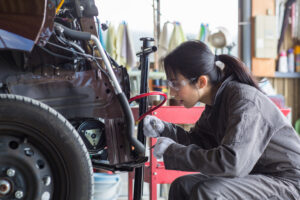
Mitchell: Vehicle complexity will continue to drive up severity, cycle times while claims volumes fall
By onAnnouncements | Market Trends
According to research by Mitchell International, collision repairers will continue to face increasing vehicle complexity, rising claims severity, and longer cycle times.
Ryan Mandell, Mitchell’s auto physical damage division director of claims performance, reports that as vehicle values and the demand for new vehicles drop, total loss frequency increases — a trend that will likely continue this year.
“Total loss market values, on the other hand, will likely return to where they would have been historically if we did not have a massive disruption during COVID,” Mandell wrote. “In fact, by May 2025, the average total loss market value is expected to be 8.5% above historical average growth in the U.S. and 13.2% above historical average growth in Canada.”
As for overall claims volume, the reduction seen last year was caused by fewer collisions due to a mild winter rather than the growing availability of advanced driver assistance systems (ADAS), he added. Insurance affordability was also a factor.
“[T]o keep auto insurance bills from increasing when premiums rise, policyholders may decide to change their coverage or raise their deductible,” Mandell wrote. “Between January 2019 and July 2024, the average first-party deductible grew by 47% in the U.S. and 30% in Canada. Drivers with higher deductibles often make different decisions when it comes to filing collision-damage claims, which could result in fewer ‘small,’ first-party claims in 2025.”
He said the collision repair and insurance industries can expect lower claims volume, higher severity, and ongoing advancements in vehicle technology that “will impact whether carriers meet — or miss — policyholder expectations.”
“As the mix of electric, hybrid, and ICE vehicles continue to shift, organizations will need to focus on adapting processes, policies, and partnerships to ensure they can deliver exceptional customer service while maintaining operational efficiency in this evolving landscape,” he wrote.
Overall, since 2019, repairing vehicles to pre-loss condition requires more parts, operations, and labor because of the increased use of lightweight components that oftentimes have to be replaced, according to Mandell’s report. He also wrote that automakers are also constructing more complex vehicles with a growing mix of materials including aluminum, composites, individual parts, and technology.
Between 2019 and 2024, the average number of replacement parts listed on a damage appraisal grew 15%, and those parts now represent more than 51% of the overall repair cost, according to Mandell.
Age is also a factor. As vehicles age, they’re becoming more complex to repair. For example, Mandell found that in 2024, according to damage appraisals for the 2019 Toyota RAV4, there was a 21% increase in operations and an 11% increase in parts compared to 2019 appraisals, based on Mitchell data. This suggests the industry’s understanding of repairing newer vehicles has evolved, he wrote.
The average number of calibrations performed on a 2019 Toyota RAV4 in 2024 increased by 22%, which wasn’t due to a change in accident type but rather a better understanding of the vehicle’s repair requirements, Mandell added.
Other signs from 2019-2024 that point to severity trends continuing to increase this year include:
-
- A 27% jump in the average repairable severity for new model-year vehicles
- A 50% increase in average repairable severity for 5-year-old automobiles
- A 6.4% increase in the frequency of 5-year-old vehicles
When it comes to claim costs, battery electric vehicles (BEVs) tend to be more expensive to repair than ICE vehicles due to their complexity. However, the cost depends on the type of hybrid, Mandell wrote. Those without an ICE have nearly identical average claims severity to BEVs while severity for those with an ICE are around the same as ICE vehicles.
“BEVs and hybrids also have higher rates of supplement submissions following the initial damage appraisal — underscoring their added complexity and the increased need to do a tear down of the vehicle to understand the full extent of the repair required,” Mandell wrote.
“Related to total loss outcomes, the tables have turned. With greater price parity between BEV and ICE vehicles in 2024, total loss frequencies are now nearly identical. Last quarter, BEVs totaled at a rate of 9.9% in the U.S. and 10.11% in Canada versus 9.98% and 11.74% respectively for newer ICE automobiles—which are comparable to BEVs in their complexity and cost to repair.
“If price parity between the two vehicle types persists in 2025, expect similar outcomes in total loss frequency in the coming year.”
The full 2025 trends report from Enlyte, Mitchell’s parent company, can be accessed here.
IMAGES
Photo courtesy of tdub_video/iStock
